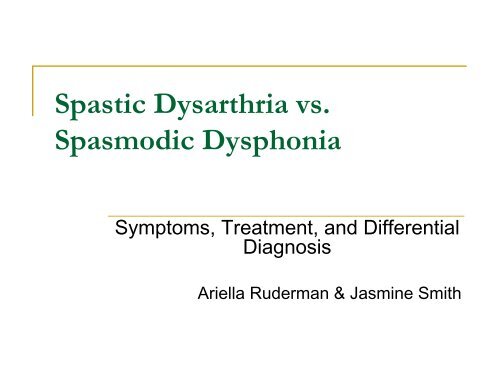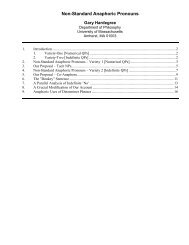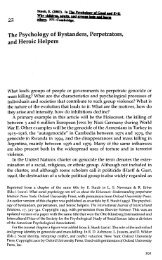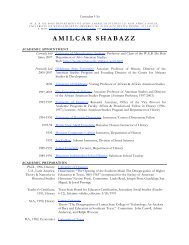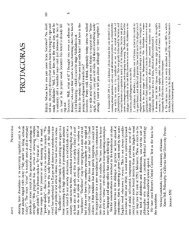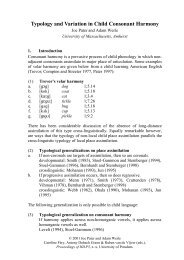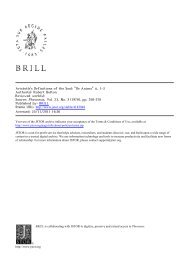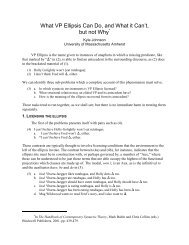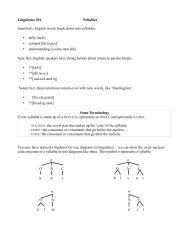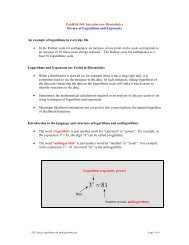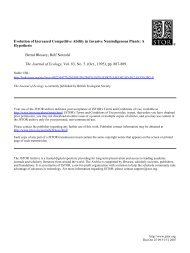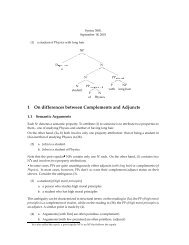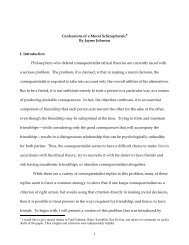Spastic Dysarthria vs. Spasmodic Dysphonia
Spastic Dysarthria vs. Spasmodic Dysphonia
Spastic Dysarthria vs. Spasmodic Dysphonia
Create successful ePaper yourself
Turn your PDF publications into a flip-book with our unique Google optimized e-Paper software.
<strong>Spastic</strong> <strong>Dysarthria</strong> <strong>vs</strong>.<br />
<strong>Spasmodic</strong> <strong>Dysphonia</strong><br />
Symptoms, Treatment, and Differential<br />
Diagnosis<br />
Ariella Ruderman & Jasmine Smith
<strong>Spastic</strong> <strong>Dysarthria</strong><br />
Caused by bilateral damage to UMN<br />
Degenerative disease, vascular causes, TBI,<br />
unknown<br />
Hypertonia, hyperreflexia, spasticity,<br />
neuropath. reflexes<br />
Speech: slow, effortful, may be hypernasal,<br />
imprecise artic., hoarseness, strain-strangle,<br />
monopitch/pitch breaks, short phrases,<br />
monoloud<br />
(Duffy 2005)
<strong>Spasmodic</strong> <strong>Dysphonia</strong><br />
Cause: probably supranuclear (once thought<br />
psychogenic)<br />
AD type<br />
VF's spasm shut<br />
Vocal strain, voice blocks<br />
AB type<br />
VF's spasm open<br />
Breathy voice, aphonic moments<br />
Worse during unvoiced consonants<br />
TASK SPECIFIC! Symptoms only occur during<br />
connected speech<br />
Stemple (2000), Finitzo (1989)
Diagnosing motor-speech disorders<br />
based on voice production and<br />
quality<br />
Darley, Aronson Brown<br />
showed each type of dysarthria manifests<br />
“clinically distinguishable auditory-perceptual<br />
characteristics.” (Duffy & Kent, 2001)<br />
Voice features correspond to physiology<br />
(shown by DAB in original tests of validity of their methods but crossvalidation<br />
using modern imaging techniques in order)<br />
Birth of the SLP as diagnostician!
Acoustic-perceptual analysis<br />
A tool developed by DAB to guide listening to the features of a<br />
patient’s speech<br />
Created a rating scale: 38 perceptual features<br />
(newer examples: GRBAS scale: Grade, Roughness, Breathiness,<br />
Asthenia, Strain; CAPE-V: Consensus Auditory Perceptual Evaluation–Voice)<br />
Advantages:<br />
Requires only a trained ear<br />
After some debate has been shown to be effective, even in novice<br />
clinicians (Bunton, et al. 2007)<br />
Disadvantages:<br />
Subjective<br />
Efficacy debated in the research<br />
Thorough training required
Other assessment tools<br />
Acoustic analysis<br />
ex. Visi-pitch,<br />
laryngostroboscopic recordings<br />
electroglottography (EGG)<br />
Assesses laryngeal functioning<br />
electromyography (EMG)<br />
Assesses muscle function<br />
videofluoroscopic assessment<br />
Swallowing test
Video Segments<br />
<strong>Spastic</strong> <strong>Dysarthria</strong> (2 mins)<br />
Breathy, slow, monotone, monoloud, effortful,<br />
hoarse<br />
Rigid left arm<br />
Possible co-existing language disorder (ex. “time”)
Video Segments<br />
<strong>Spasmodic</strong> <strong>Dysphonia</strong> (3 mins)<br />
AB Type (Mary)<br />
Breathy, especially on unvoiced sounds (/h/)<br />
AB Type, AB Type, + Tremor (Stephie)<br />
Strained voice, effortful, breathy on some unvoiced<br />
sounds, tremor on /a/<br />
AD Type, + Paroximal Dyskinesia (Jerome)<br />
Voice blocks, strained, hoarse (esp. on /a/)<br />
AD Type, + Tremor (Dot)<br />
Monopitch, monoloud, slow, effortful (Don’t confuse with<br />
PD!), voice breaks and tremor on /a/
Patient Complaints, Other Symptoms<br />
<strong>Spastic</strong> <strong>Dysarthria</strong><br />
“Speech is slower, it tires<br />
me”<br />
“My speech is nasal”<br />
Swallowing difficulty<br />
Drooling<br />
Difficult to control laughter<br />
or crying (pseudobulbar<br />
affect)<br />
Pathologic reflexes<br />
Weakness<br />
<strong>Spasmodic</strong> <strong>Dysphonia</strong><br />
Negative impact on job,<br />
social life, and emotions<br />
Vocal fatigue caused by<br />
increased effort in speech<br />
Body motions or tenseness<br />
may be present secondary<br />
to spasms (AD type)<br />
Frustration getting accurate<br />
DX
Treatment<br />
<strong>Spastic</strong> <strong>Dysarthria</strong><br />
Voice Therapy<br />
LSVT, etc.<br />
<strong>Spasmodic</strong> Dysphoina<br />
Botox to stop spasms<br />
Cycle lasting ~3-4 months<br />
Section RLN (CN X)--paresis of VF's<br />
Permanent<br />
Acupuncture (pt feels better, sounds same)<br />
Boutsen (2003), Damrose (2004), Stemple (2000)
References<br />
ASHA Leader (2001). It's Not a Nasty Cold...It's <strong>Spasmodic</strong> <strong>Dysphonia</strong>. 6,16.<br />
Baylor, C.R., Yorkston, K.M., Eadie, T.L., & Maronian, N.C. (2006). The psychosocial<br />
consequence of BOTOX injections for spasmodic dysphonia: A qualitative study of<br />
patient’s experiences. Journal of Voice, 21, 231-247.<br />
Baylor, Carolyn R.; Yorkston, Kathryn M.; Eadie, Tanya L. (2005) The consequences of<br />
spasmodic dysphonia on communication-related quality of life: A qualitative study of<br />
the insider's experiences. Journal of Communication Disorders. 38, 395-419.<br />
Bender, B.K., Cannito, M.P., Murry, T., & Woodson, G.E. (2004). Speech intelligibility in severe<br />
adductor spasmodic dysphonia. Journal of Speech, Language, and Hearing Research, 47, 21-<br />
33.<br />
Boutsen, F., Cannito, M.P., Taylor, M., Bender, B. (2002). Botox treatment in adductor<br />
spasmodic dysphonia: A meta-analysis. Journal of Speech, Language, and Hearing Research,<br />
45, 469-482.<br />
Bunton, Kate; Kent, Raymond D.; Duffy, Joseph R.; Rosenbek, John C.; Kent, Jane F. (2007).<br />
Listener Agreement for Auditory-Perceptual Ratings of <strong>Dysarthria</strong>. Journal of Speech, Language<br />
& Hearing Research, 50, 1481-1495.<br />
Bunton, Kate; Kent, Ray D.; Kent, Jane F.; Rosenbek, John C. (2000) Perceptuo-acoustic<br />
assessment of prosodic impairment in dysarthria. Clinical Linguistics & Phonetics. 13-24.<br />
Carouso, Anthony & Strand, Edythe (1999). Clinical Management of Motor Speech Disorders in Children.<br />
Thieme: New York.<br />
Damrose, J.F., Goldman, S.N., Groessl, E.J., & Orloff, L.A. (2004). The impact of long- term<br />
botulinum toxin injections on symptom severity in patients with spasmodic dysphonia. Journal<br />
of Voice, 18, 415-422.<br />
Duffy, Joseph R.; Kent, Raymond D. (2001). Darley's contributions to the understanding,<br />
differential diagnosis, and scientific study of the dysarthrias. Aphasiology, 15, 275-289.<br />
Duffy, J.R. (2005). Motor Speech Disorders: Substrates, differential diagnosis, and management (2nd<br />
ed). Elsevier Mosby: St. Louis, MO.<br />
Eadie, Tanya L.; Nicolici, Christina; Baylor, Carolyn; Almand, Kimberly; Waugh, Patricia; Maronian,<br />
Nicole. (2007) Effect of Experience on Judgments of Adductor <strong>Spasmodic</strong> <strong>Dysphonia</strong>. Annals<br />
of Otology, Rhinology & Laryngology, 116, 695-701.
Finitzo, T. & Freeman, F. (1989). <strong>Spasmodic</strong> <strong>Dysphonia</strong>, whether and where: Results of seven<br />
years of research. Journal of Speech and Hearing Research, 32, 541-555.<br />
Lee, L., Daughton, S., Scheer, S., Stemple, J.C., Weinrich, B., Miller-Seiler, T., Goeller, S., &<br />
Levin, L. (2003). Use of acupuncture for the treatment of adductor spasmodic dysphonia: A<br />
preliminary investigation. Journal of Voice, 17, 411-424.<br />
Mackenzie, K.; Millar, A.; Deary, I. J.; Wilson, J. A. (1999) Does voice therapy work? A<br />
randomized controlled trial of the efficacy of voice therapy for dysphonia. Clinical Otolaryngology &<br />
Allied Sciences, 24, 377.<br />
National <strong>Spasmodic</strong> <strong>Dysphonia</strong> Association (2008). Understanding <strong>Spasmodic</strong> <strong>Dysphonia</strong> (DVD).<br />
Roy, N., Leeper, H., Blomgren, M., & Cameron, R.M. (2001). A description of phonetic acoustic,<br />
and physiological changes associated with improved intelligibility in a speaker with spastic<br />
dysarthria. American Journal of Speech-Language Pathology, 10, 274-291.<br />
Roy, N., Mauszycki, Shannon, Merrill, Ray, Gouse, Manon, Smith, Marshall (2007) Toward Improved<br />
Differential Diagnosis of Adductor <strong>Spasmodic</strong> <strong>Dysphonia</strong> and Muscle Tension <strong>Dysphonia</strong>.<br />
Folia Phoniatrica et Logopaedica. 59, 83-90.<br />
<br />
Sapienza, G.M., Cannito, M.P., Murray, T., Branski, R., Woodson, G. (2002). Acoustic variations<br />
in reading produces by speakers with spasmodic dysphonia. Journal of Speech, Language, and<br />
Hearing Research, 45, 830-844.<br />
Sataloff, R.T., Deman-Ackah, Y.D., Simpson, L.L., Park, J.B., Zwislewski, A., Sokolow, C., &<br />
Mandel, S. (2002). Botulinim toxin type B for treatment of spasmodic dysphonia: A case report.<br />
Journal of Voice, 16, 422-424<br />
Stemple, J.C., Glaze, L.E., Klaben, B.G. (2000). Clinical Voice Pathology: Theory and<br />
management (3rd ed). Singular Publishing Group: San Deigo, CA.<br />
Tjaden, Kris; Wilding, Gregory E. (2004). Rate and Loudness Manipulations in <strong>Dysarthria</strong>: Acoustic<br />
and Perceptual Findings. Journal of Speech, Language & Hearing Research, 47, 766-783.<br />
<br />
Wingate, J.M., Ruddy, B.H., Lundy, D.S., & Lehman, J. (2005). Voice Handicap Index results for<br />
older patients with adductor spasmodic dysphonia. Voice, 19, 124-131.<br />
Yorkston, Kathryn M.; Beukelman, David R. (2004). <strong>Dysarthria</strong> Tools for Clinical Decision-Making.<br />
ASHA Leader, Vol. 9 Issue 9, p4-21, 4p


